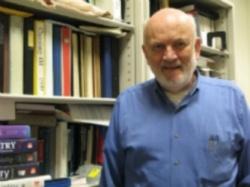Oakes Faculty Fellows
The Oakes College faculty represents a wealth of expertise from the natural sciences to the humanities, and we are proud to have some of the top scholars in the world among our faculty. Our students major in nearly every discipline at UCSC—from economics and computer science, to theater arts and Latin American and Latino studies—and they are well supported by the depth and breadth of the Oakes College faculty and the extensive knowledge of our advising team.
TBA is Oakes's faculty chair!
The Chair of the Faculty is an Academic Senate member, other than the Provost, who is elected by the college Faculty to serve a two year term, and will serve as a member of the Executive Committee.

- Title
- Professor Emeritus
- Division Physical & Biological Sciences Division
- Department
- Chemistry & Biochemistry Department
- Phone 831-459-2854, 831-459-4014, 831-459-4002
- Office Location
- Physical Sciences Building, 162
- PSB 162
- Mail Stop Chemistry
- Faculty Areas of Expertise Chemistry
Summary of Expertise
Experiments and theory for low temperature, light-activated chemical vapor deposition, achromatic focusing of molecules with external electric fields, discrete orthoganol polynomials in molecular collision theory, fractal geometry structural measures for large molecules
Research Interests
Physical Chemistry, Photo-Chemistry, UV activated Chemical Vapor, Deposition of Thin Films, Focusing of Neutral Polar Molecules, Homogeneous Nucleation, Cluster and Thinfilm Growth Mechanisms, Structure of Large Molecules, Discrete Bases in Molecular Quantum Mechanics
Roger Anderson is interested in both experimental and theoretical aspects of chemical reactions, energy transfer and gas phase chemical processes that produce solid or liquid phase products.
Some members of his research group study the reaction mechanisms of light-activated chemical vapor deposition processes with particular emphasis on deposition of low dielectric constant materials. This work includes the photolysis and pyrolysis of inorganic and organometallic molecules, the kinetics of thinfilm growth, and the properties of thinfilm materials. Rates for elementary reactions and energy transfer processes are also measured with a variety of laser based techniques. Point-of-use synthetics of CUD reactants is another active interest.
He is starting a new research program in focusing of neutral polar molecules. Focusing provides an effective separation method that has important applications in analytical chemistry, isotope separation, lithography, and spectroscopy. However many of these applications have not been used because existing electrostatic lenses have severe spherical and chromatic aberrations. But Anderson has discovered methods to correct these aberrations, and the corrected lenses will have wide application. Equipment is being built to test the corrections.
Other group members study the kinetics of homogeneous nucleation and cluster growth. Large clusters of metals and dielectrics are grown in the laboratory. An important goal of this work is the characterization of the structure of protein-sized molecules with two or three parameters that are derived from small angle X-ray scattering experiments. Clusters are also grown on computers to provide tests of the meaning of the structural parameters that can be obtained.
Anderson also conducts research on the use of discrete representations in molecular quantum mechanics. Discrete polynomials that are orthogonal with respect to summation are very useful, and have some important advantages over the use of polynomials that are orthogonal with respect to integration.
Biography, Education and Training
B.A., Carleton College
M.A., Ph.D., Harvard University
Selected Publications
- R. Pfeifer Roland, M. Bolle, and R.W. Anderson, "Hydrogen Bromide Photochemistry and Absolute Output of VUV Sources," J. Physics D. 31, 1336, 1998.
- R. W. Anderson, "Tracks of Symmetric Top Molecules in Hexapole Electric Fields," J. Phys. Chem. 101, 7664, 1997.
- R. W. Anderson, V. Aquilanti, S. Cavalli, and G. Gross, "Stereodirected Discrete Basis in Hindered Rotor Problems: Atom-Diatom and Pendular States," J. Phys. Chem. 97, 2443-2452, 1993.
- A. Pearson and R. W. Anderson, "Long-Range Pair Correlation and its Role in Small-Angle Scattering from Fractal Clusters," Phys. Rev. B 48, 5865, 1993.
